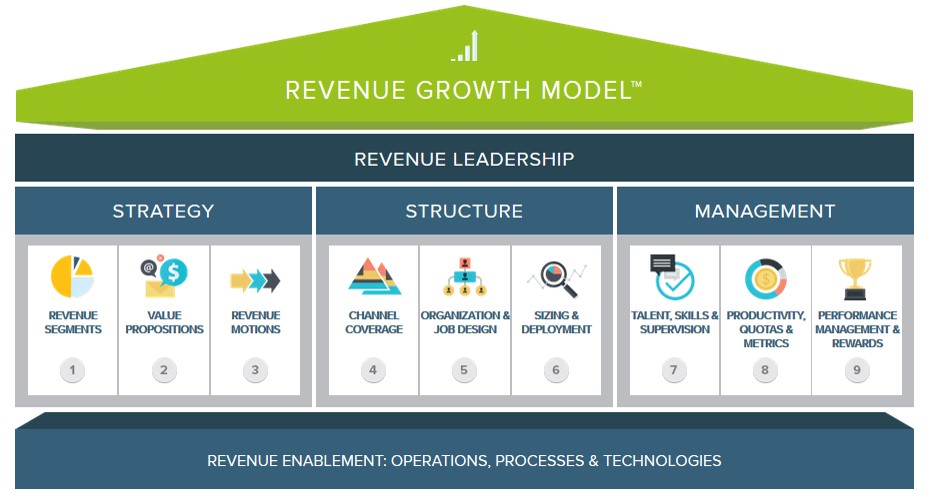Time to Lead Your Revenue Transformation
Year-end results are in and the board has summoned the VP of sales. The organization missed its sales goal and profitability dipped. Key customers are complaining that service and execution are slipping. The 20 percent of buyers that make up 80 percent of revenue are threatening to switch to competitors if they don’t receive concessions. The CFO now attends sales meetings and wonders why the company even has a sales force, remarking “at these prices, even blind squirrels could sell our products!” Lastly, despite below target performance, sales compensation costs skyrocketed.
If this scenario sounds familiar, it may be time to transform the revenue organization to ensure that the strategy, structure and management programs align and provide a clear and sustained path to growth. The Alexander Group’s Revenue Growth Model™ outlines the critical components to consider in a well-managed sales transformation: leadership, strategy, structure, management and enablement. This proven model helps to ensure that manufacturing leadership takes a holistic approach to sales transformation efforts.

Below are five rules that revenue leaders of legacy manufacturing organizations should follow when embarking on a transformation. In Alexander Group’s view, a “legacy” manufacturing organization is one that has historically succeeded with a go-to-market model focused on product features, growth via acquisition or “filling the factory.” Progressive world-class manufacturing enterprises go to their customers by delivering value-added solutions in a way that matches customers’ buying criteria and requirements for superior value.
The Five Rules for Successfully Transforming a Legacy Manufacturing Sales Model
- Mobilize the transformation team – Transformations succeed with a committed, engaged, cross-functional team. Shared ownership and cross-functional buy-in from leaders in finance, human resources and operations is the foundation for success. Just as important is having buy-in from the sales directors, managers and “rain-makers” who will translate the new strategy to day-to-day actions that move the needle. It is critical to engage these stakeholders as early as possible to plant the seeds of change.
- Listen to the voice of the customer (VOC) – Feedback from customers should serve as the compass for redesigning the go-to-customer strategy. Keep the VOC at the forefront of the journey; validate strategic decisions based on a simple criteria: “Will this change enable the organization to improve delivery of value-added, customer-centric solutions?” Ask for direct and constructive feedback from key customers as well as channel partners. Finally, consider giving the best customers and most strategic partners insight into how the new growth strategy will be a win for all.
- Let the data speak – Objectively derived sales metrics will help uncover what organizations truly need to transform. Below is a list of metrics to evaluate the health of the sales organization and identify key issues to remedy. These metrics also serve as a way to measure the effectiveness of the transformation by providing a means to track progress before, during and after the transformation. Think of it as a routine check-up for sales:

- Transform quickly and completely – What’s worse than completely remodeling an entire house? Doing so over many long days, months and years without a clear end in sight. This also holds true for redesigning the revenue organization. Avoid a tedious, protracted process by creating and communicating a clear yet flexible plan with key milestones identified. Consistently track and share progress, celebrate wins and course-correct as needed.
- Know that post-launch is when the real work starts – The new strategy, structure, sales comp program and CRM platform have all launched at the annual sales meeting. A revitalized energy can be felt through the halls. While many organizations may believe that the hardest part of the transformation is complete, it is imperative that manufacturers realize that it is actually just beginning. Establishing change champions, executing on a robust communication plan, sharing stories early and frequently, and soliciting feedback from internal and external stakeholders is essential to stabilize the transformation and activate all its benefits.
For legacy manufacturers, a sales transformation can be a challenge but can also result in a more nimble, efficient and profitable model. Many revenue leaders who have followed these five rules have seen revenue and margin gains as well as improved morale stemming from a well-crafted and clearly communicated path to growth. Whether you have led a sales transformation before or are thinking of embarking on one for the first time, following these rules will set you and your team up for a successful and prosperous journey.

Learn More
Visit Alexander Group’s Manufacturing practice page to learn more about sales transformations. Contact one of our practice leaders to find out how Alexander Group can help your company navigate through a sales transformation effort.
